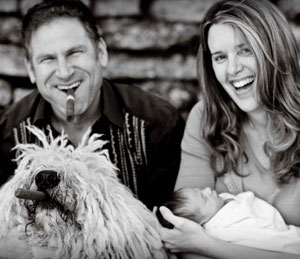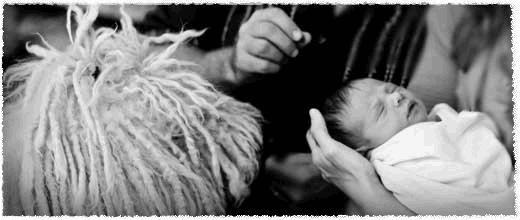Babies and Dogs
Bringing Home Baby
 Bringing home baby can be an exciting time for everyone in the household. The one exception may be your dog. A new baby, thrilling for parents, can be a source of tremendous anxiety for your dog, who may find that his world has been completely upended. However, with a little careful planning, most dogs adapt quite readily to the new arrival, and some absolutely adore babies. By following some simple guidelines, you can not only prepare your dog to accept your infant, but you can ease your own anxieties as well.
Bringing home baby can be an exciting time for everyone in the household. The one exception may be your dog. A new baby, thrilling for parents, can be a source of tremendous anxiety for your dog, who may find that his world has been completely upended. However, with a little careful planning, most dogs adapt quite readily to the new arrival, and some absolutely adore babies. By following some simple guidelines, you can not only prepare your dog to accept your infant, but you can ease your own anxieties as well.
Dog and New Baby
The first thing you’ll want to do is take an honest look at your dog’s ability to follow obedience commands. Some behaviors that could have been overlooked as forgivable nuisances before become unsafe with a newborn baby in the house. For example, jumping at the front door when you arrive or pulling on the leash both create safety hazards. You’ll want to make sure that your dog knows not to jump up on you, particularly when you are carrying a baby. (You might want to read our dog training article on How to Stop a Dog From Jumping.) Similarly, if your dog can’t go for a walk without dragging you down the street, it certainly won’t get any better with baby AND dog, once you add a stroller to the mix.
A properly-trained dog can help alleviate many of the stresses you’ll encounter in everyday life simply adjusting to your role as a new parent. At the very least, your dog should have a good grasp of the “basic five” – sit, down, stay, come, and heel – as well as a boundary stay. A boundary stay – also known as “go to bed” is similar to stay except that it means that your dog is trained to stay in a specific place, like a towel or a mat. This can be a wonderful way to keep your dog integrated into your new baby activities – simply require that he always be on a boundary stay in the baby’s room. This solves a ton of problems, like excessive licking on the baby, over-excitement, jumping, chewing baby toys, or tracking dirt around. Particularly when your baby is small and on the ground, keeping your dog from trampling him is a high priority.
Additionally, you’ll want to make sure that if your dog has any serious behavior issues, such as dog-to-dog aggression or a history of guarding his food or toys, that you invest in the help of a qualified dog trainer. These behaviors can cause big problems later on, and require a long-term approach to solving them. Similarly, if your dog has ever shown fear-related behaviors around children, such as growling, nervousness, or snapping, you’ll want to address these issues immediately. (The Zoom Room offers private dog training or you can find any qualified dog behaviorist in your area.)
Your dog should also have plenty of time to get used to all the new baby paraphernalia. Begin walking your dog with an empty stroller next to him, and practice your dog’s “go to bed” command while you scatter baby toys around on the floor in the nursery. Some expectant parents even bring home a baby doll that they swaddle in blankets. If you do this, act as you would if you had an infant – pay a lot of attention to the doll and give the dog positive attention for good behavior. A CD of a crying baby and baby sounds can be downloaded to your MP3 player, which you should tuck in the blankets with the baby. This way, your dog can get used to this new “thing” that is occupying so much of your time.
Introducing a Dog to a Baby

When you do have the baby, some experts recommend that you bring home one of the blankets from the hospital ahead of time for your dog to smell. In addition, when you enter the house with the newborn, make sure that someone else holds the baby while you properly greet your dog in the typical fashion. You’ve probably been gone for several days and he’ll have missed you! Then, allow your dog to approach you and the baby, but do not permit any licking, barking or pawing. Remember that your dog doesn’t really know how to behave yet, so thoughtful and consistent positive interactions with all things baby go a long way. When introducing a dog to a baby, have plenty of treats available to create a good association with the baby by rewarding your dog for appropriate behavior.
Once the initial introductions have been made, remember in the coming weeks to continue, as much as possible, to keep up your dog’s regular schedule and exercise routine. Although you’ll be sleep-deprived and exhausted, your dog probably won’t! Spending some time at the dog park or in an enrichment class can help keep your pup happier at home as the household gets used to the extra work an infant inevitably creates. A good variety of chew toys that he can “go through” such as bully sticks or edible dental chews can also help him stay busy and relieve stress.
Chances are, your dog will take to your baby like the puppy he never had, and enjoy your new life together as a family. There is nothing sweeter than a dog that really loves “his” baby. A little thoughtful planning can go a long way in making the transition easier, and you’ll all be happier in the long run.


Leave a comment